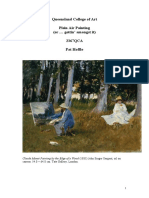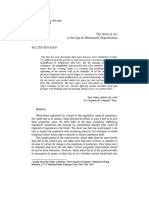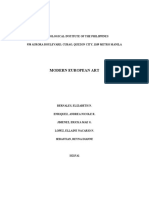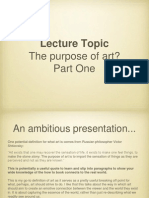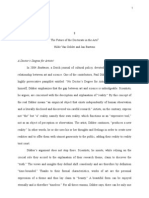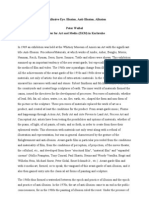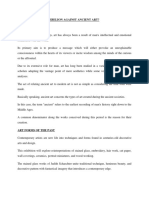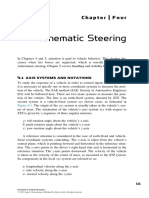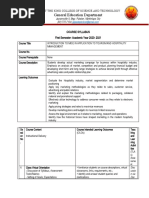0 ratings0% found this document useful (0 votes)
45 viewsBy: Katharine Kuhfrom: Break-Up: The Core of Modern Art
By: Katharine Kuhfrom: Break-Up: The Core of Modern Art
Uploaded by
Валерия Мокренко1. The art of the 20th century has been characterized by a tendency towards breaking up or dissolving traditional forms through techniques like shattered surfaces, broken color, and segmented compositions. This break up began with Impressionism's broken color and continued through movements like Cubism, Futurism, Surrealism and Abstract Expressionism.
2. Scientific developments influenced this trend, from Impressionism being influenced by studies of light and color, to modern artists being impacted by inventions like microscopes and telescopes that allow magnification and breaking things up. Developments in science and technology also reflected the fragmentation of modern life.
3. The increasing speed and overlapping experiences of modern transportation and communication are reflected in artistic techniques that show
Copyright:
© All Rights Reserved
Available Formats
Download as DOC, PDF, TXT or read online from Scribd
By: Katharine Kuhfrom: Break-Up: The Core of Modern Art
By: Katharine Kuhfrom: Break-Up: The Core of Modern Art
Uploaded by
Валерия Мокренко0 ratings0% found this document useful (0 votes)
45 views7 pages1. The art of the 20th century has been characterized by a tendency towards breaking up or dissolving traditional forms through techniques like shattered surfaces, broken color, and segmented compositions. This break up began with Impressionism's broken color and continued through movements like Cubism, Futurism, Surrealism and Abstract Expressionism.
2. Scientific developments influenced this trend, from Impressionism being influenced by studies of light and color, to modern artists being impacted by inventions like microscopes and telescopes that allow magnification and breaking things up. Developments in science and technology also reflected the fragmentation of modern life.
3. The increasing speed and overlapping experiences of modern transportation and communication are reflected in artistic techniques that show
Original Title
Break_up_Where_When_and_Why
Copyright
© © All Rights Reserved
Available Formats
DOC, PDF, TXT or read online from Scribd
Share this document
Did you find this document useful?
Is this content inappropriate?
1. The art of the 20th century has been characterized by a tendency towards breaking up or dissolving traditional forms through techniques like shattered surfaces, broken color, and segmented compositions. This break up began with Impressionism's broken color and continued through movements like Cubism, Futurism, Surrealism and Abstract Expressionism.
2. Scientific developments influenced this trend, from Impressionism being influenced by studies of light and color, to modern artists being impacted by inventions like microscopes and telescopes that allow magnification and breaking things up. Developments in science and technology also reflected the fragmentation of modern life.
3. The increasing speed and overlapping experiences of modern transportation and communication are reflected in artistic techniques that show
Copyright:
© All Rights Reserved
Available Formats
Download as DOC, PDF, TXT or read online from Scribd
Download as doc, pdf, or txt
0 ratings0% found this document useful (0 votes)
45 views7 pagesBy: Katharine Kuhfrom: Break-Up: The Core of Modern Art
By: Katharine Kuhfrom: Break-Up: The Core of Modern Art
Uploaded by
Валерия Мокренко1. The art of the 20th century has been characterized by a tendency towards breaking up or dissolving traditional forms through techniques like shattered surfaces, broken color, and segmented compositions. This break up began with Impressionism's broken color and continued through movements like Cubism, Futurism, Surrealism and Abstract Expressionism.
2. Scientific developments influenced this trend, from Impressionism being influenced by studies of light and color, to modern artists being impacted by inventions like microscopes and telescopes that allow magnification and breaking things up. Developments in science and technology also reflected the fragmentation of modern life.
3. The increasing speed and overlapping experiences of modern transportation and communication are reflected in artistic techniques that show
Copyright:
© All Rights Reserved
Available Formats
Download as DOC, PDF, TXT or read online from Scribd
Download as doc, pdf, or txt
You are on page 1of 7
Break-up: Where, When and Why
By: Katharine KuhFrom: Break-Up: The Core of Modern Art
1. The art of our century has been characterized by shattered surfaces, broken color, segmented
5compositions, dissolving forms and shredded images. Curiously insistent is this consistent emphasis on
break-up. However, dissolution today does not necessarily mean lack of discipline. It can also mean a
new kind of discipline, for disintegration is often followed by reconstruction, the artist deliberately
smashing his material only to reassemble it in new and unexpected relationships. Moreover, the
process of breaking up is quite different from the process of breaking down. And during the last
10hundred years, every aspect of art has been broken up – color, light, pigment, form, line, content,
space, surface and design.
2. In the nineteenth century, easels were moved out-of-doors and color was broken into relatively
minute areas in order to approximate the reality of sunlight and to preserve on canvas nature’s own
fleeting atmospheric effects. Known as Impressionism, this movement was the first step in a long
15sequence of experiments that finally banished the Renaissance emphasis on humanism, on three-
dimensional form and on a traditional center of interest. Here was the beginning of a gradual but
steady tendency toward diffusion in art. A few years later, Vincent Van Gogh transformed broken
color into broken pigment. Less interested in realistic light than in his own highly charged emotions,
he allowed smashing rhythmic brushstrokes to mirror his personal turbulence. In doing so he foretold
20twentieth-century Expressionism, that aptly named movement which relied on pitted surfaces, broken
outlines, unpredictable color and scarred textures to intensify emotional expression. As the
Impressionists were bent on freeing nature from sham, so the Expressionists hoped to liberate their
own feelings from all trace of artificiality.
3. Perhaps the most revolutionary break-up in modern art took place a little more than fifty years
25ago with the advent of Cubism. It was the Cubists, Picasso, Braque, Duchamp, Picabia, Léger,
Delaunay and Juan Gris, who responded to the inordinate multiplicity of present-day life by breaking
up and arbitrarily rearranging transparent planes and surfaces so that all sides of an object could be
seen at once. As the Cubists broke through the boundaries of conventional form to show multiple
aspects simultaneously, their Italian colleagues, the Futurists, hoped to encompass the uninterrupted
30motion of an object at one time. This they tried to do by a series of overlapping transparent forms
illustrating the path of an object as it moved through space.
4. With Surrealism came still another kind of break-up, the break-up of chronology. Frankly
influenced by Freudian discoveries, this movement splintered time sequence with an abandon
borrowed from the world of fragmented dreams. Content was purposely unhinged in denial of all
35rational expression, allowing disconnected episodes to re-create the disturbing life of our unconscious.
At the same time, perspective and distance often became severely dislocated. Denying the orderly
naturalism of the Renaissance, painters today project space and distance from innumerable eye levels,
intentionally segmenting their compositions into conflicting perspectives. We look from above, from
below, from diverse angles, from near, from far – all at one and the same time (not an unfamiliar
40experience for eyes accustomed to air travel). Here again is the Cubist idea of simultaneity, the
twentieth-century urge to approach a scene from many different directions in a single condensed
encounter.
5. Finally we come to the total break-up of Abstract Expressionism, a technique that celebrates the
specific act of painting (sometimes appropriately called Action Painting). Now everything is shattered
45– line, light, color, form, pigment, surface and design. These canvases defy all the old rules as they
reveal the immediate spontaneous feelings of the artist in the process of painting. There is no one
central idea, no beginning, no end – only an incessant flow and flux where lightning brush-strokes
report the artist’s impulsive and compulsive reactions. The pigment actually develops a life of its own,
almost strong enough to hypnotize the painter. Here break-up turns into both content and form, with
Break-up / 3
50the impetuous paint itself telling the full story. No naturalistic image is needed to describe these artists’
volatile feelings.
6. As one looks back over the last hundred years, the history of break-up becomes a key to the
history of art. Why painters and sculptors of this period have been so involved with problems of
dissolution is a question only partly answered by the obvious impact of modern scientific methods of
55destruction. One cannot deny that the last two devastating wars and the possibility of a still more
devastating one to come do affect our daily thinking. Since the discovery of the atom bomb, science
has become almost synonymous with destruction. The influence of contemporary warfare with its
colossal explosions and upheavals has unquestionably had much to do
with the tendency toward fragmentation in art, but there have been other and earlier causes.
607. From the beginning, it was science in one form or another that affected modern painting and
sculpture. In nineteenth-century Europe the interest in atmospheric phenomena was not an isolated
expression limited to the Impressionists. At that time, numerous scientists were experimenting with all
manner of optical color laws, writing widely on the subject as they investigated the relationship of
color to the human eye. Artists like Monet and Seurat were familiar with these findings and not
65unnaturally applied them to their paintings. It would be a grave mistake to underestimate the influence
of contemporary scientific research on the development of Impressionism. The wonders of natural
light became a focus for nineteenth-century artists exactly as the magic of artificial light stimulated
painters of the present century. If the earlier men were more interested in rural landscapes seen out-of-
doors in the sunlight, the later artists quite reasonably concentrated on city scenes, preferably at night
70when man-made luminosity tends to puncture both form and space.
8. Other scientific investigations also exerted considerable influence on present-day painters and
sculptors. Inventions like the microscope and telescope, with their capacity to enlarge, isolate and
probe, offer the artist provocative new worlds to explore. These instruments, which break up structures
only to examine them more fully, demonstrate how details can be magnified and separated from the
75whole and operate as new experiences. Repeatedly artists in recent years have exploited this idea,
allowing one isolated symbol to represent an entire complex organism. Miró often needs merely part of
a woman’s body to describe all women, or Léger, one magnified letter of the alphabet to conjure up the
numberless printed words that daily bombard us.
9. As scientists smash the atom, so likewise artists smash traditional forms. For how, indeed, can
80anyone remain immune to the new mushroom shape that haunts us day and night? The American
painter, Morris Graves, put it well recently, “You simply can’t keep the world out any longer. Like
everyone else, I’ve been caught in our scientific culture.” This is not to say that painters are interested
in reproducing realistic scenes of atomic explosions, but rather that they are concerned with the
reactions accompanying these disaster. It is just possible that, with their extra-sensitized intuition,
85artists may have unconsciously predicted the discovery of atomic energy long before “the bomb”
became a familiar household word, for the history of break-up in art antedates the history of nuclear
break-up.
10. Even the invention of the X-ray machine has brought us closer to penetrating form. We no longer
think of outer coverings as solid or final: we know they can be visually pierced merely by rendering
90them transparent. We have also learned from science that space penetrates everything.
11. The sculptor Gabo claims, “Space is a reality in all of our experiences and it is present in every
object… That’s what I’ve tried to show in certain of my stone carvings. When they turn, observe how
their curved forms seem interpenetrated by space.” For the artist today, noth8ing is static or permanent.
The new popular dances are no more potently kinetic than the new staccato art forms that everywhere
95confront us.
Break-up / 4
12. With the dramatic development of speedier transportation and swifter communication comes a
visual overlapping responsible for much of contemporary art. In modern life one is simultaneously
subjected to countless experiences that become fragmented, superimposed, and finally rebuilt into new
experiences. Speed is a cogent part of our daily life.
10013. How natural, then, that artists reflect this pressure by showing all sides of an object, its entire
motion, its total psychological content in one concerted impact. It is almost as if the pressures of time
had necessitated a visual speed-up not unlike the industrial one associated with the assembly line and
mass production. Speed with its multiple overlays transforms our surroundings into jagged, interrupted
images.
10514. Modern technology and science have produced a wealth of new materials and new ways of using
old materials. For the artist this means wider opportunities. There is no doubt that the limitations of
materials and nature of tools both restrict and shape a man’s work. Observe how the development of
plastics and light metals along with new methods of welding and brazing have changed the direction of
sculpture. Transparent plastic materials allow one to look through an object, to see its various sides
110superimposed on each other (as in Cubism or in an X-ray). Today, welding is as prevalent as casting
was in the past. This new method encourages open designs, often of great linear agility, where
surrounding and intervening space becomes as important as form itself. In fact, it becomes a kind of
negative form. While bronze casting and stone carving are techniques more readily adapted to solid
volumes, welding permits perforated metal designs of extreme versatility that free sculpture from the
115static restrictions which for centuries have moored it to the floor.
15. More ambiguous than other scientific inventions familiar to modern artists, but no less
influential, are the psychoanalytic studies of Freud and his followers, discoveries that have infiltrated
recent art, especially Surrealism. The Surrealists, in their struggle to escape the monotony and
frustrations of everyday life, claimed that dreams were the only hope. Turning to the irrational world
120of their unconscious, they banished all time barriers and moral judgments to combine disconnected
dream experiences from the past, present and intervening psychological states. The Surrealists were
concerned with overlapping emotions more than with overlapping forms. Their paintings often become
segmented capsules of associative experiences. For them, obsessive and often unrelated images
replaced the direct emotional messages of Expressionism. They did not need to smash pigment and
125texture; they went beyond this to smash the whole continuity of logical thought.
16. There is little doubt that contemporary art has taken much from contemporary life. In a
period when science has made revolutionary strides, artists in their studios have not been unaware of
scientists in their laboratories. But this has rarely been a one-way street. Painters and sculptors, though
admittedly influenced by modern science, have also molded and changed our world. If break-up has
130been a vital part of their expression, it has not always been a symbol of destruction. Quite the contrary;
it has been used to examine more fully, to penetrate more deeply, to analyze more thoroughly, to
enlarge, isolate and make more familiar certain aspects of life that earlier we were apt to neglect. In
addition, it sometimes provides rich multiple experiences so organized as not merely to reflect our
world, but in fact to interpret it.
135
5Break-up / 5
Post-reading assignment:
1. Translate into English:
сегментована композиція
наблизитися до реальності
розпливчаті форми
зберегти на полотні
скороминучі атмосферні ефекти
зруйнована поверхня
передбачити Експресіонізм 20 століття
емоційно заряджений
непередбачувані кольори
підсилювати вираження емоцій
визволяти природу від прикидання
звільняти почуття від фальшивості
(штучності),
розпад
розірвані контури
ритмічні мазки пензля
три вимірний простір
рубцьована текстура
мольберти винесли на відкрите повітря
вигнати
поступова та стала тенденція до дифузії в
мистецтві
показувати різноманітні аспекти одночасно
Концепція «руйнування» заповнила всі
напрямки мистецтва
виконувати рухи
суміщені (накладені один на одний) образи
прозорі форми
невловимі (мінливі, змінливі) почуття
художника
збурене життя несвідомого
з різних кутів
ігнорувати всі старі правила
руйнівна війна
впливати на повсякденні роздуми
відкривати спонтанні почуття
передавати імпульсивні реакції
імпульсивні (стрімкі) фарби
велика помилка
недооцінювати вплив наукових досліджень
сільські пейзажі
міські сцени
Break-up / 6
впливати на теперішніх художників
ізольовані символи
породжувати в уяві
неясний
тікати від монотонності та розчарувань
повсякденного життя
ігнорувати часові перепони та моральні
судження
трощити фарбу
формувати (моделювати) світ
схильні зневажати
пронизувати глибше
віддзеркалювати та інтерпретувати світ
1402. Complete the expressions, using these words:
Shattered, revolutionary, volatile, pitted, rural, emotional expression, considerable influence the
reality, images, the disturbing life of our unconscious, old rules, grave, vital, the artist’s impulsive
reactions, monotony and frustrations of everyday life, fleeting, all time barriers, on canvas, one’s
thinking.
1451. ……….compositions 11. …….feelings
2. ……….. surfaces 12. to report….
3. …… textures 13. to exert…..
4. to approximate…… 14. to banish …..
5. to intensify…… 15. a ….. part of smth.
1506. overlapping……… 16. ……….strides
7. to recreate…… 17. to escape…...
8. to defy…. 18. …….effects
9. ….landscapes 19. to affect……
10. A….. mistake 20. to preserve…
1553. Find in the article and write out all the words and expressions that convey the idea of
“break-up”.
4. Questions for Discussion
1. Stating that the art of the 20-th century has been characterized by "consistent emphasis on break-
up", the author proceeds to outline this tendency in different art movements. Discuss how "break-up"
160was manifested in the following:
(a) Impressionism
(b) Expressionism
(c) Cubism
(d) Surrealism
165(e) Abstract Expressionism
1. Has contemporary warfare influenced art? If so, in what way?
2. In paragraph 2, the author speaks of "broken colour" and "broken pigment", what does she
mean?
3. How has science or modern technology affected modern painting and sculpture?
1704. What influence has speed had on modern art?
5. What role have Freud's psychoanalytic studies played in some types of modern art?
Exploring Ideas
Break-up / 7
1. Do you agree with Katherine Kuh's thesis about modern art? Give your reasons pro or con.
1752. Think of some art form that especially interests you, such as movies, music, drama, literature,
etc., and apply Kuh's thesis about break-up. To what degree is the thesis true or not true? Illustrate
your observations with examples, if you can.
You might also like
- Auditory Neuroscience - Making Sense of Sound (2010) PDFDocument367 pagesAuditory Neuroscience - Making Sense of Sound (2010) PDFFelipe Helf100% (4)
- Abstract Film and Beyond-Malcolm LeGriceDocument160 pagesAbstract Film and Beyond-Malcolm LeGriceSangue CorsárioNo ratings yet
- The Painter's Secret Geometry: A Study of Composition in ArtFrom EverandThe Painter's Secret Geometry: A Study of Composition in ArtRating: 5 out of 5 stars5/5 (5)
- Niti AayogDocument46 pagesNiti AayogLavkesh Bhambhani100% (1)
- Rules of Art NowDocument9 pagesRules of Art NowDr. Teresa M. TiptonNo ratings yet
- 41370602Document3 pages41370602Omega ZeroNo ratings yet
- Seven Strategies To Teach Students Text Comprehension - Reading Topics A-Z - Reading RocketsDocument12 pagesSeven Strategies To Teach Students Text Comprehension - Reading Topics A-Z - Reading RocketsMary Child100% (1)
- Keywords para Dorks de Paginas para ComprasDocument7 pagesKeywords para Dorks de Paginas para ComprasNoe ResendizNo ratings yet
- Printmaking in Expansion. Space and Time PDFDocument24 pagesPrintmaking in Expansion. Space and Time PDFtudor toaderNo ratings yet
- paintingDocument6 pagespaintingvladamappyNo ratings yet
- Secondary Arts 10 Q1 Module1Document7 pagesSecondary Arts 10 Q1 Module1TIPAY, EMELIE L.No ratings yet
- Abstract in Contemporary ArtsDocument14 pagesAbstract in Contemporary ArtsArjay M. LusterioNo ratings yet
- ArtsDocument13 pagesArtssheedyvyne.salasNo ratings yet
- Nineteenth-Century Painting (Compass History of Art)Document250 pagesNineteenth-Century Painting (Compass History of Art)Ljubica Velkova100% (2)
- Hoffie, P. 2016. Plein Air Painting (Or... Gettin' Amongst It')Document40 pagesHoffie, P. 2016. Plein Air Painting (Or... Gettin' Amongst It')Aaron Marc Perkins100% (1)
- Art Styles in Contemporary ArtDocument8 pagesArt Styles in Contemporary ArtChianti Gaming09No ratings yet
- Canvas Chronicles A Symphony of Colors in the World of ArtFrom EverandCanvas Chronicles A Symphony of Colors in the World of ArtNo ratings yet
- What The Sixties Meant To MeDocument8 pagesWhat The Sixties Meant To MeFrank HobbsNo ratings yet
- Showflipper Presents: 40 Pa Inti NG Tec Hniques OffineartDocument27 pagesShowflipper Presents: 40 Pa Inti NG Tec Hniques OffineartKhushboo ChaturvediNo ratings yet
- The Modernist and Post Modernist Age of Art Alienation and Reconciliation of A Lost AudienceDocument7 pagesThe Modernist and Post Modernist Age of Art Alienation and Reconciliation of A Lost Audienceweebudda4393No ratings yet
- Abstract ArtDocument9 pagesAbstract Artapi-193496952No ratings yet
- ModernandcontemoparyartsDocument7 pagesModernandcontemoparyartsBarista sastraNo ratings yet
- An End To The End of Art ?Document8 pagesAn End To The End of Art ?Bru PereiraNo ratings yet
- Achim Hochdorfer - How The World Came inDocument16 pagesAchim Hochdorfer - How The World Came incowley75100% (1)
- Modern and Contemporary ArtDocument5 pagesModern and Contemporary ArtMARLA JOY LUCERNANo ratings yet
- Ann Temkin - Ab Ex at MoMADocument5 pagesAnn Temkin - Ab Ex at MoMAcowley75No ratings yet
- Topic 2_ Wester-wps Office_100720Document36 pagesTopic 2_ Wester-wps Office_100720babyselpongoslagonoyNo ratings yet
- Crow - Modern Art in The Common CultureDocument288 pagesCrow - Modern Art in The Common CultureEdiciones Selva Arcana100% (1)
- Week 13 Contemporary ArtDocument4 pagesWeek 13 Contemporary ArtJade CarbonNo ratings yet
- The Work of Art in The Age of Mechanical ReproductionDocument26 pagesThe Work of Art in The Age of Mechanical ReproductionJan Patrick CastilloNo ratings yet
- GROHMANN, W. New Art Around The World. Painting and Sculpture ( (1966) )Document520 pagesGROHMANN, W. New Art Around The World. Painting and Sculpture ( (1966) )Jose Muñoz100% (2)
- Name: Afia Fahim & Taqveem Ali Course: Modern Poetry Semester: 3-A DATE: 19 MARCH, 2021Document3 pagesName: Afia Fahim & Taqveem Ali Course: Modern Poetry Semester: 3-A DATE: 19 MARCH, 2021Afia FaheemNo ratings yet
- Conceptual DesignDocument5 pagesConceptual DesignHAFSA ZAFARNo ratings yet
- Note Impressionism VCRDocument12 pagesNote Impressionism VCRnazwill66No ratings yet
- Douglas Crimp, "On The Museum's Ruins"Document18 pagesDouglas Crimp, "On The Museum's Ruins"AnneFilNo ratings yet
- 34.1higgins IntermediaDocument6 pages34.1higgins IntermediaEleanor Poole100% (1)
- Four PeriodsDocument7 pagesFour PeriodsLyka Jasmine PandacanNo ratings yet
- Why Art Became Ugly - Stephen HicksDocument6 pagesWhy Art Became Ugly - Stephen HicksMarcel AntonioNo ratings yet
- Sculpture: University in Sarajevo Faculty of Philosophy Department of EnglishDocument9 pagesSculpture: University in Sarajevo Faculty of Philosophy Department of EnglishlarisalisicaNo ratings yet
- 001 Art-AppreciationDocument13 pages001 Art-AppreciationBtrz QnnsNo ratings yet
- Natasha Edmonson Kandinsky ThesisDocument44 pagesNatasha Edmonson Kandinsky ThesisJorge PezantesNo ratings yet
- Impressionist Metropolitan PDFDocument256 pagesImpressionist Metropolitan PDFSofija Grubač100% (2)
- Modern-Art-Definition1Document22 pagesModern-Art-Definition1marisakhvadze2005No ratings yet
- Art Appreciation PageDocument48 pagesArt Appreciation PageCHERALDINE SALAZARNo ratings yet
- ImpressionismDocument63 pagesImpressionismLivija MikicNo ratings yet
- Art AppDocument9 pagesArt Appelizabeth bernalesNo ratings yet
- Caught in Between Modern & Contemporary ADocument119 pagesCaught in Between Modern & Contemporary AAlliana Denice Vicencio100% (4)
- The Purpose of Art - Part OneDocument12 pagesThe Purpose of Art - Part OneStuart HendersonNo ratings yet
- Walter Benjamin - The Work of Art in The Age of Mechanical Reproduction (1936)Document31 pagesWalter Benjamin - The Work of Art in The Age of Mechanical Reproduction (1936)seth_arimainyuNo ratings yet
- A Doctor's Degree For Artists!Document19 pagesA Doctor's Degree For Artists!nicolajvandermeulenNo ratings yet
- Architecture and How to Sketch it - Illustrated by Sketches of Typical ExamplesFrom EverandArchitecture and How to Sketch it - Illustrated by Sketches of Typical ExamplesRating: 2 out of 5 stars2/5 (1)
- Modern Art To ImpressionismDocument46 pagesModern Art To ImpressionismJoseph BoylesNo ratings yet
- Lawrence Alloway, The Arts and The Mass Media'Document3 pagesLawrence Alloway, The Arts and The Mass Media'myersal100% (2)
- The Allusive Eye. Illusion, Anti-Illusion, Allusion Peter Weibel Center For Art and Media (ZKM) in KarlsruheDocument4 pagesThe Allusive Eye. Illusion, Anti-Illusion, Allusion Peter Weibel Center For Art and Media (ZKM) in KarlsruhePreng LeshiNo ratings yet
- Communities of SenseDocument12 pagesCommunities of Senseanyme10No ratings yet
- Art in History, 600 BC - 2000 AD: Ideas in ProfileFrom EverandArt in History, 600 BC - 2000 AD: Ideas in ProfileRating: 4 out of 5 stars4/5 (5)
- Module 6 ART APPRECIATIONDocument19 pagesModule 6 ART APPRECIATIONJuliana David AustriaNo ratings yet
- Was Modernism A Rebelion Against Ancient ArtDocument6 pagesWas Modernism A Rebelion Against Ancient ArtSohil SankalpNo ratings yet
- Debating TabsDocument2 pagesDebating TabsВалерия МокренкоNo ratings yet
- Running Head: Possessing A Time-Turner 1Document3 pagesRunning Head: Possessing A Time-Turner 1Валерия МокренкоNo ratings yet
- Possessing A Time-TurnerDocument3 pagesPossessing A Time-TurnerВалерия МокренкоNo ratings yet
- Lerarunning Head: Lerapossessing A Time-Turner 1Document3 pagesLerarunning Head: Lerapossessing A Time-Turner 1Валерия МокренкоNo ratings yet
- Discussion:: Post Your Answers To The FollowingDocument1 pageDiscussion:: Post Your Answers To The FollowingВалерия МокренкоNo ratings yet
- Annotated Bibliography and Research Proposal AssignmentDocument3 pagesAnnotated Bibliography and Research Proposal AssignmentВалерия МокренкоNo ratings yet
- A History of The English Language184834580-1Document5 pagesA History of The English Language184834580-1Валерия МокренкоNo ratings yet
- Higher Education in The USADocument12 pagesHigher Education in The USAВалерия МокренкоNo ratings yet
- Ryton R-4-200NA: Polyphenylene SulfideDocument3 pagesRyton R-4-200NA: Polyphenylene SulfideMatteo BaldiniNo ratings yet
- Mechatronics and Machine Vision in Practice 4 John Billingsley all chapter instant downloadDocument65 pagesMechatronics and Machine Vision in Practice 4 John Billingsley all chapter instant downloadasaayaseran100% (16)
- Micro Controller Assignment 2 (All 24 From Shiva Prasad)Document88 pagesMicro Controller Assignment 2 (All 24 From Shiva Prasad)Shashank M ChanmalNo ratings yet
- Taurus Zodiac Sign: Sanskrit Name: Vrishabha Meaning of Name: The BullDocument4 pagesTaurus Zodiac Sign: Sanskrit Name: Vrishabha Meaning of Name: The Bullfadila batoulNo ratings yet
- Msds-Methyl Orange IndicatorDocument7 pagesMsds-Methyl Orange IndicatorHayleyNo ratings yet
- Selina Concise Physics Solutions Class 10 Chapter 7 SoundDocument28 pagesSelina Concise Physics Solutions Class 10 Chapter 7 Sounddurgeshsharma7969No ratings yet
- Underwater ArchaelogyDocument1 pageUnderwater ArchaelogyzucchinaliluciaNo ratings yet
- Chapter Four - Kinematic Steering - 2015 - Essentials of Vehicle DynamicsDocument11 pagesChapter Four - Kinematic Steering - 2015 - Essentials of Vehicle DynamicsJulián AvellaNo ratings yet
- Ejercicios de Maquinas de Desplazamiento Positivo: Elias González Edinson Hurtado Carlos JulioDocument8 pagesEjercicios de Maquinas de Desplazamiento Positivo: Elias González Edinson Hurtado Carlos JulioCarlos JulioNo ratings yet
- Name Program: MAELT Professor: Doc. Junie Rosales:: de Lara, Siegfred ZDocument6 pagesName Program: MAELT Professor: Doc. Junie Rosales:: de Lara, Siegfred ZJerwin CanterasNo ratings yet
- Summer Internship ReportDocument28 pagesSummer Internship ReportKumar Rishikesh100% (1)
- Domestic Admission GuideDocument4 pagesDomestic Admission Guidepeteryang855No ratings yet
- PCK 126 Global CitizenshipDocument2 pagesPCK 126 Global CitizenshipMerylcyne Bangsao SimsimNo ratings yet
- Naval Vessels and Surface Combatants Market Analysis and Forecast To 2026Document4 pagesNaval Vessels and Surface Combatants Market Analysis and Forecast To 2026rymouachNo ratings yet
- SK-600II Brochure (En)Document2 pagesSK-600II Brochure (En)Zákány Zoltán0% (1)
- 1047 Service Manual - SDocument152 pages1047 Service Manual - SPedro AraripeNo ratings yet
- Gas-Insulated Medium Voltage Switchgear Use of SF Insulating Gas Manual HB 605/01 E - Manual BA 427/09 EDocument40 pagesGas-Insulated Medium Voltage Switchgear Use of SF Insulating Gas Manual HB 605/01 E - Manual BA 427/09 EGeorgi NikolovNo ratings yet
- General Education Department: Christ The King College of Science and TechnologyDocument8 pagesGeneral Education Department: Christ The King College of Science and TechnologyRaimound MarcuzNo ratings yet
- "Tons of F Ing Energy!": Inside The Biggest Guitar Album of The YearDocument100 pages"Tons of F Ing Energy!": Inside The Biggest Guitar Album of The YearPumpkn100% (2)
- Cracking TOEFL iBT 2019-ListeningDocument9 pagesCracking TOEFL iBT 2019-ListeningmarcusNo ratings yet
- P51702-10-Kit For Overhaul of Fuel Valve TIER IIDocument2 pagesP51702-10-Kit For Overhaul of Fuel Valve TIER IIFilipe FilipeNo ratings yet
- Dissertation Proposal Oral Defense Powerpoint PresentationDocument5 pagesDissertation Proposal Oral Defense Powerpoint PresentationBestWriteMyPaperWebsiteClarksville100% (1)
- English 6 Q4 - W3 - D1Document6 pagesEnglish 6 Q4 - W3 - D1Eugel GaredoNo ratings yet
- SITXWHS003 IMPLEMENT AND MONITOR WORK HEALTH AND SAFETY PRACTICES 1 .DocmDocument25 pagesSITXWHS003 IMPLEMENT AND MONITOR WORK HEALTH AND SAFETY PRACTICES 1 .DocmHabeeba MoinuddinNo ratings yet
- VLSI Unit 1 - MOSDocument86 pagesVLSI Unit 1 - MOSskh_19870% (1)
- Thermodynamics MsDocument14 pagesThermodynamics MsLaila HassanNo ratings yet

















